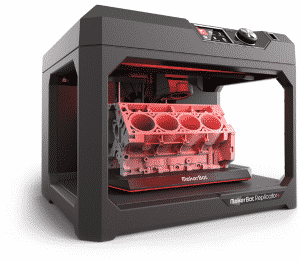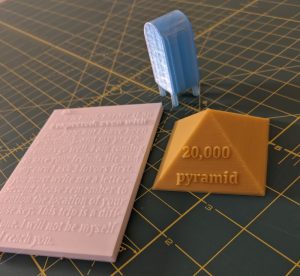Thanks to a generous grant from the Safeway/Albertsons Innovation in Education program, St. John has a 3D printer available for student projects.
The 3D printer is available to all St. John students for use on class projects or service projects. We also have periodic 3D printer events after school where students work through specific 3D modeling and printing projects.
Class Projects
Are you a 5th grader working on your galleon project? A 6th grader working on a genre book talk project which requires a visual aid? A 7th grader working on a simple machines science project? An 8th grader working on a science inquiry project? Or any other St. John student who needs a custom visual aid to support their class project? Then add “3D printer” to your bag of tricks along with the old standbys of “clay,” “papier-mache,” or “popsicle sticks.”
Get started using TinkerCAD.com in your web browser on your own — DO THE TUTORIALS. There are definitely some tricks to navigating TinkerCAD you will need to spend 20 minutes to learn. Check out free models available to incorporate into your project at thingiverse.com.
Here is an example of a project a 6th-grade student recently completed in support of their mystery genre book talk:
Service Projects
Did your grandma break a piece of her vacuum cleaner? Does your teacher need a custom desk caddy to organize their popsicle sticks, paperclips, and dry erase markers? Does the school play or carnival need a custom prop you think you could design and print, with a little help? Have you seen the “MAXIMUM OCCUPANCY” signs in Egan Hall and inside the church which were designed by St. John students and printed on our 3D printer? The 3D printer is available for you to bring your ideas for helping someone else or contributing to the greater good into reality.
3D Modeling Workshops
Watch NewsViews for signup opportunities for after school 3D printer special events for students in grades 5 – 8. In the past, we have built custom boxes using parametric 3d modeling in OpenSCAD, with decorations and labels applied in TinkerCAD. Last year, over 70 students designed and received a custom printed box from the 3D printer! This year we may do some 3D modeling design contests and additional project-oriented design sessions, including transforming a 2D sketch to a simple 3d model for printing.
How does this benefit student learning?
It is another means through which students can express their creativity. It enables students to bring their original ideas to life in the physical world. The ability to customize and personalize every project fosters a sense of ownership and pride.
3D modeling and the use of 3D CAD modeling software is a useful skill in and of itself. The techniques and tools used on our 3D printer are transferable to professional modeling tools, and quickly has an effect of empowering the student as they build the skills required to solve many real-world problems.
Mathematics concepts from geometry and ratios are fundamental to the 3D modeling process. Understanding shapes and how new shapes may be generated by overlapping or subtracting shapes from one another reinforces lessons taught in the mathematics curriculum.
The process of bringing an idea into the physical world is fraught with surprises and setbacks. Things rarely work as expected the first time. The process develops resilience and problem-solving skills.
Links to resources we will use:
Thingiverse is a good place to look at existing models others have shared. Any of these can be downloaded and printed as-is or customized for your use.
MakerBot Our printer is a MakerBot Replicator+. MakerBot print “slices” the object into horizontal…slices, for printing. It is also the program used to connect to the printer and start print jobs.
Prior to “slicing” the project in MakerBot Print, projects may be created and edited in the following software. This is where students will create and edit their projects. When done, export your project to the .stl or .obj file format. There are dozens of other options, but these represent a great place to start, and all are free to use:
TinkerCad you can do a lot with this and it is probably the easiest to learn. Start here and do the tutorials.
OpenSCAD to “code” your model with precise repeatable directions rather than twitchy mouse movements, check this unique program. Very easy to scale or alter existing examples to different sizes and shapes.








